 With all the recent winter weather Hampton Roads has been experiencing, you may be noticing new issues arising with your house that you don’t normally have to deal with. You’ve probably had to shovel snow from your driveway or walkways, and you may have needed to drip your faucets to avoid pipes freezing. But there’s also something you should be aware of with your roof during inclement winter weather, and it’s called “ice damming.”
With all the recent winter weather Hampton Roads has been experiencing, you may be noticing new issues arising with your house that you don’t normally have to deal with. You’ve probably had to shovel snow from your driveway or walkways, and you may have needed to drip your faucets to avoid pipes freezing. But there’s also something you should be aware of with your roof during inclement winter weather, and it’s called “ice damming.”
What is Ice Damming?
You know the beautiful icicles that form along the edge of your roof after a winter storm? While they look charming, they are actually indicative of an ice dam.
Ice damming happens after a measurable snow event. Snow settles somewhat evenly on your roof, and provided it’s not a massive amount of snow that would cause weight bearing issues, your roof is perfectly capable of handling it. The problem occurs after the storm when heat starts to melt the snow. The heat may come from inside the attic due to insufficient insulation or other air leaks to the attic that allow warm air in, or it may come from the sun. In either case, snow starts to melt and water runs down the roof toward your gutters. Again, if this happens gradually, and if your gutters are clear, and if the temperature does not drop precipitously, your home’s structure should manage all of this just fine.
Unfortunately those ideal circumstances don’t always happen. What often happens is that the snow starts to melt, and when it reaches the edge of the roofline it begins to freeze. This is because the edge of a roof is likely less warm – not having been heated from living or attic space underneath. Then as the sun goes down, and temperatures drop, the melted snow compiles, freezes and creates a dam at the edge of the roofline. This dam causes moisture to back up, and can also cause shingles to lift, allowing water to get underneath resulting in interior leaks. If this happens, you may notice damp spots on your ceiling or walls, peeling paint or mildew.
What should you do if it happens?
Trying to remove the ice buildup with household tools, shovels, etc. can damage your roof, not to mention be incredibly dangerous for you. Throwing salt on the roof can cause damage to any plants underneath and may not work quickly or effectively enough.
If the ice dam has caused a leak into your attic or scuttle space, you can point a box fan at it to freeze it and stop additional water damage until the snow is able to melt and drain away.
You can also use a roof rake which is a long-handled tool that you can use to rake snow off the roof while you stay safely on the ground. It may not remove existing ice dams, but if you use it right after a snow event, it can prevent ice dams from forming.
How can you prevent future ice dams?
It may surprise you to know that even if a leak occurs from an ice dam, it’s not necessarily because your roof was not installed properly or because of true roof damage. In fact, most ice dams are caused by issues inside the house, not the roof.
The main cause of ice dams is the difference in temperature between the center of the roof and the eaves. Maintaining an even temperature is the first step to avoiding the issue. You can help create an even temperature under your roof by increasing the ventilation in your attic, adding insulation and sealing any air leaks that may be allowing warm air into your attic or scuttle. You should discuss these options with a licensed contractor, as it is not advisable to DIY these important fixes.
How can we help?
If your roof has sustained damage from an ice dam during the winter weather we’ve been experiencing in the Hampton Roads region, contact Andrews Roofing today. We provide roof repair services in addition to full roof replacements to residents of Virginia Beach, Chesapeake, Norfolk, Portsmouth, Suffolk and other cities in the region, and we’d be happy to provide you with a free estimate.
